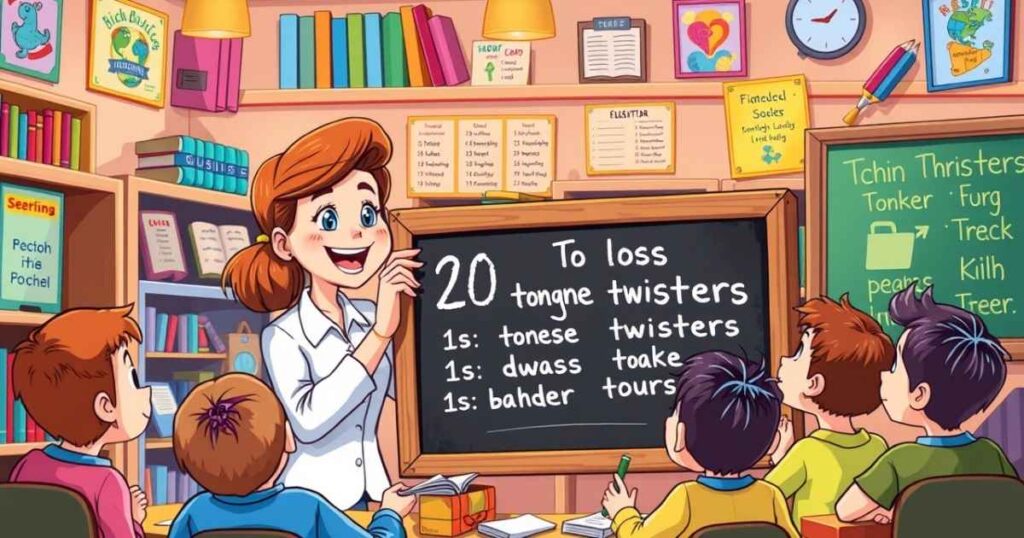R Tongue Twisters are a fun way to improve your pronunciation. These tricky phrases focus on the “R” sound, making them a great tool for language learners and public speakers alike. R Tongue Twisters challenge your vocal muscles and help with speech clarity. By practicing R Tongue Twisters, you can master the rumbling “R” sound and improve your overall articulation.
If you’re looking for ways to boost your speech skills, try tongue twisters with R. These tongue twisters with R work well in r tongue twisters speech therapy. They focus on the coordination of your tongue and lips for perfect pronunciation. Whether you’re practicing tongue twisters with R or just having fun with r word tongue twisters, you’ll notice improvement in your speech patterns and fluency. Give them a try, and challenge yourself to say them faster!
What is a tongue twister that starts with R?
A tongue twister that starts with the letter R is a phrase that challenges your pronunciation of the “R” sound. These phrases often repeat similar sounds to test your ability to say them quickly and clearly. One example is “Rory the rabbit runs rapidly.” Practicing such phrases helps improve your speech skills and agility by focusing on the coordination of your tongue and lips. It’s a fun way to enhance your vocal clarity and articulation.
These exercises are often used in language classes and speech therapy. They help with mastering the pronunciation of tricky sounds, like the “R” sound, by forcing the speaker to articulate clearly. Tongue twisters with repetitive sounds also improve fluency and help develop better speech patterns. Practicing regularly can boost your confidence in both everyday conversations and public speaking engagements.
Rolling and Resonant Tongue Twisters

Rolling and resonant tongue twisters are fun and challenging exercises that focus on the “R” sound. These phrases help improve articulation, making speech clearer. They involve repeating tricky “R” sounds quickly, forcing you to practice proper tongue coordination. Mastering them requires focus and repetition, which improves both fluency and clarity.
When practicing R Tongue Twisters, the primary goal is to strengthen your vocal muscles. The repeated movement of the tongue and lips trains your mouth to articulate the “R” sound effectively. Over time, this leads to clearer pronunciation. The rhythm of these tongue twisters also makes the practice enjoyable.
As you repeat tongue twister, you’ll start noticing an improvement in how you pronounce words with the “R” sound. The exercise strengthens your mouth’s ability to form the sound quickly, which improves speech clarity. This is especially beneficial for those struggling with certain speech patterns. The more you practice, the better you’ll get.
These tongue twisters are also useful in speech therapy. Speech therapists often incorporate tongue twister into their sessions to help clients develop better pronunciation and articulation. Regular practice leads to stronger vocal control, helping overcome common pronunciation challenges. It’s a simple but effective technique that delivers noticeable results.
Practicing tongue twister not only helps with pronunciation but also with overall language development. They encourage phonemic awareness, which is the ability to hear, identify, and manipulate sounds in words. This foundational skill is vital for improving reading and writing abilities, making tongue twisters a valuable part of language learning.
For language learners, R Tongue Twisters provide an entertaining and engaging way to practice new sounds. They encourage focus on the sound structure of words, especially those with tricky consonants like “R.” By repeating these twisters, learners become more familiar with the pronunciation of the target language, which improves fluency.
One of the challenges in language development is mastering specific sounds, especially the “R” sound. tongue twister help learners focus on the precision of their speech patterns. The rhythm and repetition required to say these twisters correctly make it easier to pronounce the “R” sound clearly, even at higher speeds.
The key to mastering tongue twister is repetition. The more you practice, the easier it becomes to articulate the “R” sound. This practice not only improves pronunciation but also helps with speech confidence. The regular use of tongue twisters trains your brain to quickly recall the correct speech patterns when speaking naturally.
Speech clarity is another benefit of tongue twister. By focusing on the coordination of the tongue and lips, these exercises enhance vocal agility. The clearer you can pronounce the “R” sound in isolation, the more effectively you can use it in everyday speech. This improves your overall communication.
For actors and public speakers, R Tongue Twisters are a great tool for vocal warm-ups. They help prepare the vocal cords and improve pronunciation before performing. By incorporating these twisters into daily practice, voice artists can enhance their verbal agility, ensuring their speech is both clear and resonant.
When using a tongue twister, it’s important to focus on speed and accuracy. Over time, you’ll learn to say them faster without losing clarity. This helps improve your overall speaking speed without sacrificing speech quality. It’s a challenge that pushes you to improve both mentally and physically.
In speech therapy, tongue twister are often used to address speech disorders. By helping individuals focus on the “R” sound, these exercises aid in overcoming difficulties with articulation. Regular practice can significantly enhance a person’s ability to speak clearly, leading to greater confidence in communication.
Phonological awareness is crucial for young learners and tongue twisters can be a fun way to develop this skill. By identifying the repeated sounds in these phrases, children strengthen their ability to manipulate sounds in words. This improves their overall language abilities and lays the foundation for better reading and writing.
For those struggling with rapid speech or unclear pronunciation, tongue twister offer a solution. They provide a structured way to slow down and focus on each word’s individual sounds. As you get better at these tongue twisters, your speech will naturally become more clear and controlled in everyday conversation.
Learning to articulate challenging sounds like the “R” can be tough, but tongue twister make the process easier. These exercises break down the complexity of speech into manageable steps. By practicing regularly, you’ll soon be able to pronounce words with confidence and clarity, improving your overall communication skills.
The joy of tongue twister lies in their playful nature. They’re not just practical exercises but also a fun way to challenge yourself. The more you practice, the better you’ll get, and the process of mastering these twisters can become a game of skill and speed, adding an element of excitement to your learning.
While R Tongue Twisters are often associated with speech therapy, they are also a great tool for everyday speech improvement. Whether you’re a language learner or someone looking to improve your vocal clarity, these exercises can help. They challenge you to be more mindful of your pronunciation, which ultimately leads to better communication.
The repetition in tongue twister helps engrain the correct articulation into your muscle memory. With enough practice, your tongue and lips become more coordinated, allowing you to produce the “R” sound with ease. This muscle memory is crucial for fluent, clear speech in both casual and professional settings.
Another benefit of tongue twister is the improvement they bring to mental agility. These exercises require focus and quick thinking as you try to keep up with the speed and rhythm of the phrases. Over time, this helps improve your cognitive abilities, which are crucial for clear and effective communication.
For public speakers, the ability to articulate each sound clearly is vital. tongue twisters help improve vocal precision, ensuring that each word is pronounced correctly. This is especially important in speeches, where clarity can greatly impact the message being delivered. These exercises help speakers maintain sharpness throughout their presentations.
Another reason for the popularity of tongue twister is their versatility. They can be used in a wide range of settings, from language classes to speech therapy sessions. Their effectiveness is evident in how they help learners at all levels improve their pronunciation and speech clarity.
Also a great way to develop a more natural speaking rhythm. By practicing these twisters regularly, you develop a sense of pacing that helps you speak more fluidly. This rhythmic pattern is important for both casual and formal speaking situations, as it enhances overall communication.
For language learners, tongue twister help improve fluency by challenging you to pronounce difficult sounds accurately. The faster and more confidently you say the twisters, the more fluent your speech becomes. This practice ultimately enhances your ability to speak naturally and confidently in the target language.
The Rumbling R’s: An Exploration of Tongue Twisters
The “R” sound can be tricky for many people to pronounce clearly. It requires careful coordination between the tongue and lips to achieve a distinct, rumbling sound. Mastering this sound can be a challenge, but it’s an essential part of clear speech.
One effective way to improve this is through repetitive exercises that focus on the “R” sound. These exercises help strengthen the vocal muscles and improve articulation. They also enhance phonemic awareness, making it easier to pronounce difficult words.
Incorporating these exercises into daily practice can lead to better speech patterns and increased fluency. With time and repetition, the “R” sound becomes more natural and clear.
Origins and Evolution
The origins of tongue twisters can be traced back to early language development exercises. They were used as a fun way to improve pronunciation and speech clarity. Throughout history, various cultures created these phrases to challenge vocal agility and articulation skills.
Over time, these verbal challenges evolved from simple language drills to complex, playful exercises. As linguistics and phonetics advanced, tongue twisters became an essential tool in speech therapy and language learning. They helped individuals develop better control over their speech and pronunciation.
In modern times, tongue twisters have found their way into entertainment, acting, and public speaking. They are now used by professionals like voice artists and actors to warm up their vocal muscles. The playful nature of these exercises makes them a popular activity in language classes, social gatherings, and competitions.
Impact on Language Development
Tongue twisters have a significant impact on language development. They engage different aspects of speech, including pronunciation, articulation, and vocal coordination. Practicing these phrases helps strengthen the muscles involved in speech production, which is essential for clear communication. By focusing on tricky sounds, they promote better control of speech movements, leading to improved clarity.
Additionally, these exercises help individuals with phonemic awareness, which is the ability to recognize and manipulate sounds in words. This skill is crucial for reading, writing, and overall language proficiency. Regular practice can enhance the understanding of sound structure, making it easier to produce words correctly.
For younger learners, engaging in these activities helps develop essential cognitive skills. They improve mental agility, which aids in memory and learning. By challenging the mind with repetitive sounds, children can build strong language foundations that contribute to their overall communication abilities.
Furthermore, language learners benefit from practicing such phrases, as it boosts fluency and helps them overcome language barriers.
Enduring Popularity

The appeal of tongue twisters has lasted for generations, captivating both children and adults. Their enduring popularity can be attributed to their fun and challenging nature, which provides an engaging way to work on speech skills. These playful phrases not only entertain but also serve a practical purpose by helping with articulation and clarity in speech. Over time, they have evolved from simple games to valuable tools for improving language proficiency.
Their widespread use in language classes and speech therapy has contributed to their long-lasting popularity. As more people realize the benefits of mastering these tricky phrases, they continue to be a staple in education. Speech therapists often incorporate these exercises into their sessions, helping clients improve their pronunciation and vocal coordination.
In addition, their presence in social gatherings and competitions adds to their appeal. People enjoy testing their skills and challenging one another to see who can say the phrases the fastest without stumbling. This competitive aspect makes them not only a useful exercise but also a source of amusement.
The versatility of these phrases also plays a role in their popularity. They can be adapted to suit various levels of difficulty, from beginners to advanced speakers. This makes them accessible to a wide range of people, from language learners to public speakers.
As language learners seek new ways to refine their pronunciation, these exercises continue to be a fun and effective method for mastering verbal challenges. The playful yet effective nature of these phrases ensures their lasting place in language development.
Tongue Twisters to practice your “r” sounds
- Rory’s red rabbits raced rapidly around the rocky road.
- Roger’s rambunctious rooster raised ruckus on the roof.
- Riley’s rare red roses were ready for the royal reception.
- Rita’s rhythmic running reached the rickety road’s rise.
- Ruby’s red rubber duck rapidly floated across the river.
- Randy’s rowdy raccoons raced through the rough ravine.
- Reginald’s rowdy parrot rapidly ruffled its radiant feathers.
- Ruthie’s rare roses reached the radiant rose garden.
- Ray’s robust roar reverberated through the remote region.
- Rosa raced around the riverbank, reaching the rugged rocks.
- Rickety tricycles rolled rapidly, racing around the rocky road.
- Rory’s roaring rabbits rushed around the rickety railing.
- Roger ran rapidly through the rough rocky ravine.
- Ralph’s rapid reactions made him the best racer in the region.
- Reggie’s red raspberries ripened in the radiant sunshine.
- Rick’s rambunctious raccoon ransacked the rowdy ravine.
- Rita’s rolling rocks rattled around the rocky riverbed.
- Reed’s rapid rhythm rippled through the roaring river’s rise.
- Riley’s racing rabbit ran rapidly, reaching the riverbank.
- Randy’s rambunctious raccoon raced across the rugged road.
These playful sentences are a fun way to practice pronunciation and improve your articulation. By repeating these phrases, you work on the coordination of your tongue and lips, enhancing your ability to pronounce the tricky “r” sounds clearly. Whether you are preparing for speech therapy or simply looking to have fun with language, these tongue twisters provide a useful and engaging challenge. Consistent practice can lead to clearer, more confident speech and a stronger grasp of verbal fluency.
Related Guide:
20 “Farewell Lunch Invite Message” To Use In 2025
Examples for r tongue twisters
Here are some tongue twisters focusing on the “r” sound:
- Rory the rabbit rapidly raced ’round the rugged rocks.
- Riley’s rabbit repeatedly ran rapidly through the rough roads.
- Roger’s rambunctious rooster roared relentlessly around the ranch.
- Ruby’s red rubber duck rocked on the rippling river.
- Ray’s robust roar reverberated across the rocky ridge.
- Ruthie’s rare red roses reflected radiant rays of sunshine.
- Randy the rambler roamed the rugged, remote riverbank.
- Reginald’s rowdy parrot ruffled its feathers in the rain.
- Rosa’s remarkable rollerblades rolled rapidly on the rough road.
- Rory’s roaring rabbits raced across the rolling hills.
- Red lorries raced rapidly down the rough road.
- Sally sells sea shells by the shimmering shore.
- Peter Piper picked a peck of pickled peppers.
- Fuzzy Wuzzy was a fuzzy bear, full of fun.
- Betty Botter bought a bit of butter.
- Toy boats bobbed by the blue bay.
- Unique New York has a unique name in the big city.
- The great Greek grape growers gathered giant grapes.
- Irish wristwatches twist quickly while ticking.
- Swiss wristwatches swirled swiftly in the Swiss snow.
These tongue twisters are great for practicing the tricky “R” sound. Whether you’re working on articulation or just having fun, they help develop vocal coordination. By practicing these phrases, you improve your speech clarity and fluency. The rhythmic patterns they follow make it easier to master pronunciation, especially for challenging sounds. Regular repetition will strengthen your vocal muscles and sharpen your speech skills.
Top 20 hardest tongue twisters
Some tongue twisters are incredibly challenging, even for the most skilled speakers. These tricky phrases push pronunciation to the limit, making them fun yet tough to master.
- Peter Piper picked a peck of pickled peppers.
- How much wood would a woodchuck chuck if a woodchuck could chuck wood?
- She sells sea shells by the sea shore.
- Betty Botter bought some butter, but she said the butter’s bitter.
- Fuzzy Wuzzy was a bear. Fuzzy Wuzzy had no hair.
- Six slippery snails slid slowly south.
- A black bug bleeds black blood, what color blood does a blue bug bleed?
- How can a clam cram in a clean cream can?
- Crisp crusts crackle and crunch.
- The big black bug bled black blood, what color blood did the blue bug bleed?
- Rory the rabbit ran around the rocky road.
- She sees cheese.
- The thirty-three thieves thought that they thrilled the throne throughout Thursday.
- Silly sheep sleep soundly.
- Red lorry, yellow lorry.
- Tommy Tucker tried to tie a ten-toner to a tight tree.
- Which wristwatches are Swiss wristwatches?
- A dozen dim, damp, double-dyed dragonflies danced in the dusk.
- If two witches would watch two watches, which witch would watch which watch?
- A tutor who tooted a flute tried to tutor two tooters to toot.
Tongue twisters are both fun and difficult to master. They improve speech clarity and help with vocal coordination. These challenging phrases test your ability to articulate quickly and clearly, making them great tools for language development and speech therapy. With practice, you can improve your pronunciation and enjoy the challenge of mastering these tough tongue twisters!
What are 20 tongue twisters?

Tongue twisters are fun phrases that challenge pronunciation and speech clarity. They feature repetitive sounds and patterns that test vocal agility and coordination, making them great for language practice.
- She sells seashells by the seashore.
- Peter Piper picked a peck of pickled peppers.
- How much wood would a woodchuck chuck if a woodchuck could chuck wood?
- Fuzzy Wuzzy was a bear.
- Betty Botter bought some butter, but she said the butter’s bitter.
- Red lorry, yellow lorry.
- Six slippery snails slid slowly seaward.
- A black bug bleeds black blood.
- The great Greek grape growers grow great Greek grapes.
- Unique New York.
- How much wood would a woodchuck chuck if a woodchuck could chuck wood?
- Can you can a can as a canner can can a can?
- A snake snuck up on a snack.
- Chester cheetah chews a chunk of cheap cheddar cheese.
- Sheep should sleep in a shed.
- The quick brown fox jumps over the lazy dog.
- I saw Susie sitting in a shoe shine shop.
- How many boards could the Mongols hoard if the Mongol hordes got bored?
- Which wristwatches are Swiss wristwatches?
- Tommy Tucker tried to tie Tammy’s turtle.
Tongue twisters are an enjoyable and challenging way to enhance pronunciation skills. They help improve articulation, voice clarity and speed by requiring repetition of tricky sounds and patterns.
FAQ’s
1. What are R Tongue Twisters?
R Tongue Twisters help improve the clarity of the “R” sound. They train your vocal muscles, enhancing articulation and pronunciation over time.
2. How do these exercises help with speech therapy?
Practicing R Tongue Twisters in speech therapy strengthens tongue coordination and pronunciation. They are effective in improving speech clarity and enhancing the “R” sound.
3. Can these exercises improve pronunciation?
Yes, R Tongue Twisters are great for improving pronunciation. Repeating them regularly helps fine-tune articulation and strengthens the “R” sound for better speech.
4. Who benefits from these exercises?
Language learners, actors and public speakers can all benefit from R Tongue Twisters. They improve speech clarity, vocal control and overall articulation.
5. Are these exercises fun to practice?
Definitely! R Tongue Twisters are a fun way to practice pronunciation. They challenge your speech while keeping things enjoyable and improving verbal agility.
Conclusion
Practicing R Tongue Twisters is an effective and fun way to improve pronunciation. By repeating R Tongue Twisters, you can strengthen your vocal muscles and enhance your articulation. These exercises help with the coordination of your tongue and lips, making the “R” sound clearer. Whether you are learning a new language or improving your speech, R Tongue Twisters are a valuable tool.
For those in r tongue twisters speech therapy, these exercises are especially helpful. They focus on the repetitive sounds of the “R” sound, which helps improve speech clarity and fluency. Regular practice of R Tongue Twisters can help anyone master the difficult “R” sound. With consistent practice, you’ll notice improvements in your pronunciation and overall speech patterns. So, keep practicing R Tongue Twisters to build your speech skills and enjoy the process!

Zion Blaze is a dedicated administrator with 5 years of experience in managing operations, optimizing workflows, and ensuring efficiency. Skilled in leadership, problem-solving, and team coordination.

